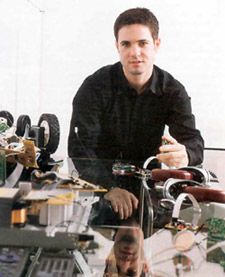|
|
 |
 |
 |
 |
|
ALUMNI PROFILEMike Latham ’97: Wheeling and Dealing in Architecture
The typical young Columbia College graduate likes to wheel and deal, but Mike Latham ’97 has made a living out of it — especially the wheeling. Latham, a Williamsburg, Brooklyn-based architect, challenges the most mundane of interior design principles — that furniture must be stationary. In Latham’s vision of a living space, nothing is committed to its piece of the floor: It’s all on wheels, even the guest room. The 27-year-old, who was profiled in the Spring 2002 Home Design issue of The New York Times Magazine, runs his own company, the Arts Corporation, which seeks to link architecture with art and technology. He applies this cross–pollination of ideas on scales ranging from individual rooms to big buildings and even creates what he calls “high-tech furniture,” which, Latham explains, is a traditional piece of furniture such as a bed, desk or table, but one with electronic intelligence embedded in it, allowing it to perform nontraditional functions. “It’s smarter than your average furniture,” he says. Latham is not the type to leave his work at the office. His 1,900-square-foot Kent Avenue loft in Williamsburg, one of the first living spaces he developed, is the embodiment of his work. A guest bedroom can be wheeled around easily with handles. Movable glass shelves filled with books make up the walls to rooms. Cupboards don’t have to stay in the kitchen. Latham’s design vision doesn’t stop at designing apartments. Arts Corporation, founded in 1999, undertakes design projects that include two basic themes, according to Latham: technology and intelligence. Current projects include four prefabricated, wind-and-solar powered homes in Pennsylvania with remote control heating and surveillance systems. He also is working on a bar in Washington, D.C., that will feature “kinetic furniture:” multifunctional, moving furniture. Arts Corporation’s clients come from the public and private sectors and include individuals and institutions alike, Latham says. He reaches his clients, which have included a United Nations consulting office and record producer David Walis, through “hard-won personal connections” and “hard-won publicity relating to finished work.”Most of his clients meet Latham after they have had a chance encounter with one of his creations and are impressed. Latham says his projects are a product of the information age — an age that he thinks the world of architecture could stand to invest in. “Everything in our lives is getting smaller and more intelligent. Things are multifunctional. I wonder why furniture and architecture remain lame and quiet,” he says. “I don’t see why they shouldn’t have the same kind of intelligence that other objects in our lives have.” Arts Corporation, which deals in architecture, sculptures and robotics, employs three full-time employees and a handful of consultants. Many of the firm’s projects are in the prototyping phase right now, which makes them more expensive, but Latham says his goal is to make his designs affordable to the average buyer. While traditional “high art” is expensive, Latham says mass production will help make Arts Corporation’s creations more economically viable. This means mass producing Arts Corporation innovations such as “home robotics” and “intelligent furniture” — items that do more than just sit and perform their traditional functions. Latham says there’s no reason why your basic coffee table can’t also function as an Internet station. Latham, who’s from Miami, majored in architecture at the College and received his master’s in architecture from the School of Architecture, Planning & Preservation in 2000. Latham credits the College’s tradition of encouraging students to challenge established principles helped lead him in the direction he took with his work. “That sort of spirit of openness and questioning permeates the undergraduate architecture department,” he says. “It was a good place to start turning over normal standards.” P.W.
|
|
||||||||||||||||||||||||||||||||||||||||||||||||||||||||
